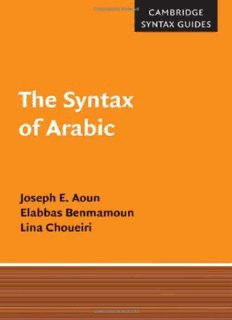Table Of ContentThe Syntax of Arabic
RecentresearchonthesyntaxofArabichasproducedvaluableliteratureonthe
majorsyntacticphenomenafoundinthelanguage.ThisguidetoArabicsyntax
provides an overview of the major syntactic constructions in Arabic that have
featuredinrecentlinguisticdebates,anddiscussestheanalysesprovidedforthem
intheliterature.Abroadvarietyoftopicsiscovered,includingargumentstructure,
negation,tense,agreementphenomena,andresumption.Thediscussionofeach
topic sums up the key research results and provides new points of departure
forfurtherresearch.ThebookalsocontrastsStandardArabicwithotherArabic
varieties spoken in the Arab world. An engaging guide to Arabic syntax, this
book will be invaluable to graduate students interested in Arabic grammar, as
wellassyntactictheoristsandtypologists.
joseph e. aoun is President of Northeastern University, Boston,Massach-
usetts.
elabbas benmamoun is Professor in the Department of Linguistics at
theUniversityofIllinoisatUrbana-Champaign.
lina choueiri is Associate Professor in the English Department at the
AmericanUniversityofBeirut.
cambridge syntax guides
Generaleditors:
P.Austin,B.Comrie,J.Bresnan,D.Lightfoot,I.Roberts,N.V.Smith
Responding to the increasing interest in comparative syntax, the goal of the
Cambridge Syntax Guides is to make available to all linguists major findings,
bothdescriptiveandtheoretical,whichhaveemergedfromthestudyofparticular
languages.Theseriesisnotcommittedtoworkinginanyparticularframework,
butratherseekstomakelanguage-specificresearchavailabletotheoreticiansand
practitionersofallpersuasions.
Written by leading figures in the field, these guides will each include an
overview of the grammatical structures of the language concerned. For the
descriptivist, the books will provide an accessible introduction to the methods
andresultsofthetheoreticalliterature;forthetheoretician,theywillshowhow
constructions that have achieved theoretical notoriety fit into the structure of
thelanguageasawhole;foreveryone,theywillpromotecross-theoreticaland
cross-linguisticcomparisonwithrespecttoawell-definedbodyofdata.
Otherbooksavailableinthisseries
O.Fischeretal.: TheSyntaxofEarlyEnglish
K.Zagona: TheSyntaxofSpanish
K.Kiss: TheSyntaxofHungarian
S.Mchombo: TheSyntaxofChichewa
H.Thrainsson: TheSyntaxofIcelandic
P.Rowlett: TheSyntaxofFrench
R.D.Borsleyetal.: TheSyntaxofWelsh
C.-T.J.Huangetal.: TheSyntaxofChinese
The Syntax of Arabic
JOSEPH E. AOUN
NortheasternUniversity,Boston
ELABBAS BENMAMOUN
UniversityofIllinois,Urbana-Champaign
LINA CHOUEIRI
AmericanUniversityofBeirut
cambridge university press
Cambridge,NewYork,Melbourne,Madrid,CapeTown,Singapore,Sa˜oPaulo,Delhi
CambridgeUniversityPress
TheEdinburghBuilding,CambridgeCB28RU,UK
PublishedintheUnitedStatesofAmericabyCambridgeUniversityPress,NewYork
www.cambridge.org
Informationonthistitle:www.cambridge.org/9780521659864
(cid:2)c CambridgeUniversityPress2010
Thispublicationisincopyright.Subjecttostatutoryexception
andtotheprovisionsofrelevantcollectivelicensingagreements,
noreproductionofanypartmaytakeplacewithout
thewrittenpermissionofCambridgeUniversityPress.
Firstpublished2010
PrintedintheUnitedKingdomattheUniversityPress,Cambridge
AcataloguerecordforthispublicationisavailablefromtheBritishLibrary
ISBN978-0-521-65017-5hardback
ISBN978-0-521-65986-4paperback
CambridgeUniversityPresshasnoresponsibilityforthepersistenceor
accuracyofURLsforexternalorthird-partyinternetwebsitesreferredto
inthispublication,anddoesnotguaranteethatanycontentonsuch
websitesis,orwillremain,accurateorappropriate.
Contents
Listofabbreviations pageix
1 IssuesinthesyntaxofArabic 1
1.1 TheArabiclanguage(s) 1
1.1.1 ThedevelopmentofArabic 1
1.1.2 TheModernArabicdialectsandModernStandardArabic 2
1.2 GeneralcharacteristicsofthesyntaxofArabic 2
1.2.1 ThesyntaxoftheA-domain 3
1.2.2 ThesyntaxoftheA(cid:3)-domain:unboundeddependencies
inArabic 7
2 ClausestructureinArabic 12
2.1 Introduction 12
2.2 TheCPlayer 13
2.3 TenseinArabic 18
2.3.1 ProjectingtenseinArabic 18
2.3.2 Themorphologyoftense 19
2.3.3 Thesyntaxoftense 27
2.4 VerbdisplacementinArabic 28
2.5 Motivatingverbmovementtotense 33
2.6 Thesyntaxofverblesssentences 35
2.7 Conclusion 45
3 Thesyntaxofsubjects 46
3.1 Introduction 46
3.2 Subjectposition(s) 49
3.2.1 Twosubjectpositions 49
3.2.2 Onesubjectposition 50
3.3 ClausalstructureandthestatusoftheVP 52
3.3.1 Idioms 52
3.3.2 VPcoordination 54
3.3.3 Wh-asymmetries 54
3.3.4 Bindingasymmetries 56
v
vi Contents
3.4 Thestatusofpreverbalsubjects 57
3.4.1 Agreementasymmetriesandthepositionofthesubject 57
3.4.2 Indefinitesubjects 62
3.4.3 Broadvs.narrowsubjects 64
3.5 Thestatusofpostverbalsubjects 66
3.5.1 CopularsentencesinMoroccanArabic 67
3.5.2 Existentialconstructions 69
3.6 Conclusion 71
4 Sententialagreement 73
4.1 Introduction 73
4.2 Subject–verbagreementasymmetryinStandardArabic 75
4.2.1 Expletivesubjectsandpooragreement 76
4.2.2 Fullagreementasanincorporatedpronoun 78
4.2.3 Syntacticanalysesoftheagreementasymmetry 80
4.2.4 Morphologicalanalysisoftheagreementasymmetry 83
4.3 FirstconjunctagreementintheModernArabicdialects 85
4.4 FirstconjunctagreementinStandardArabic 90
4.5 Impersonalagreement 92
4.6 Conclusion 95
5 Thesyntaxofsententialnegation 96
5.1 Introduction 96
5.2 SententialnegationintheModernArabicdialects 96
5.2.1 Thesyntacticrepresentationandderivationof
sententialnegation 98
5.2.2 Thestatusofthetwonegativemorphemesmaand sˇ 103
5.2.3 Anegativecopula? 107
5.3 SententialnegationinStandardArabic 110
5.3.1 laaanditstensedvariants 112
5.3.2 laysa 114
5.3.3 Thenegativemaa 116
5.4 Personagreementandpositiveimperativesversusnegative
imperatives 120
5.5 NegativepolarityitemsinMoroccanArabic 123
5.6 Conclusion 125
6 Modesofwh-interrogation 127
6.1 Introduction 127
6.2 Wh-wordsandwh-interrogativesinArabic 128
6.3 Thegapstrategyandtheresumptivestrategy 130
6.3.1 Resumptivewh-interrogativesandd-linking 139
6.3.2 Thesyntaxofwh-constituents 143
Contents vii
6.3.3 Long-distancewh-dependenciesandislandsensitivity 144
6.3.4 Summary 147
6.4 ClassIIresumptiveinterrogatives 147
6.5 wh-in-situ 153
6.5.1 Thedistributionofwh-wordsinsitu 154
6.5.2 Summaryandanalysis 158
6.6 Conclusion 161
7 Restrictiverelatives 163
7.1 Introduction 163
7.2 Twotypesofrelativeclauses 163
7.3 Thegapstrategyinrestrictiverelatives 166
7.4 Gappedrelativesandislandsensitivity 169
7.5 Thedistributionofweakresumptivepronounsinrestrictive
relatives 172
7.6 Islandsensitivityinrestrictiverelativeswithweakresumptive
pronouns 173
7.6.1 Theabsenceofislandsensitivitywithweakresumptive
pronouns 173
7.6.2 Abstractnounrelativizationandislandsensitivity 175
7.6.3 TherelativizationofidiomaticNPchunks 179
7.7 Indefiniterelatives,idiomchunks,andabstractnounrelativization 184
7.7.1 Resumptioninindefiniterelativesandthenatureofthe
antecedent 185
7.7.2 Restrictiverelativesandmovement 186
7.8 Conclusion 188
8 Clitic-leftdislocationandfocusconstructions 190
8.1 Introduction 190
8.2 Clitic-leftdislocationinArabic 191
8.2.1 Thedistributionofclitic-leftdislocatedNPs 191
8.2.2 Clitic-leftdislocationandleftdislocation 192
8.2.3 ThenatureoftheCLLDedelement 194
8.2.4 ThedistributionofpronominalcliticsinsideCLLD
constructions 200
8.3 FocusconstructionsinArabic 201
8.3.1 Thedistributionoffrontedfocusedphrases 203
8.3.2 Thenatureofthefrontedfocusedphrases 206
8.3.3 Focusfrontingandislandsensitivity 208
8.4 AnalysesoffocusfrontingandCLLDinArabic 208
8.5 Conclusion 213
viii Contents
9 ThesyntaxoftheArabicleftperiphery 214
9.1 Introduction 214
9.2 RevisitingfocusfrontingandCLLD 215
9.3 Aminimalityaccount 219
9.3.1 TworepresentationsofCLLDconstructions 219
9.3.2 ReconstructioneffectsinCLLD 220
9.3.3 InterceptioninLebaneseArabic 221
9.3.4 Interceptionandbinding 223
9.4 InteractionbetweenfocusfrontingandCLLDinStandardArabic 224
9.5 Interception:aconstraintonthewell-formednessofmovement
chains? 225
9.6 Interception:aconstraintonderivations? 227
9.7 Broadsubjectconstructionsrevisited 229
9.7.1 BroadsubjectsandCLLD 231
9.7.2 Broadsubjectsandinterception 233
9.8 Conclusion 235
References 237
Index 245
Abbreviations
1 FirstPerson
2 SecondPerson
3 ThirdPerson
s Singular
p Plural
m Masculine
f Feminine
Acc Accusative
Nom Nominative
Gen Genitive
Dat Dative
Asp AspectualMarker
Subj Subjunctive
Ind Indicative
Comp Complementizer
Neg NegativeMarker
Fut FutureMarker
Prog Progressive
FM FocusMarker
ix

